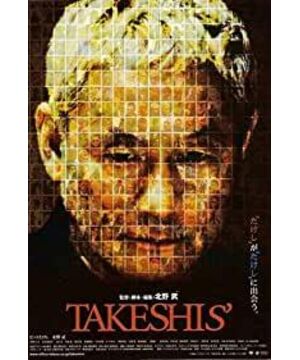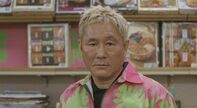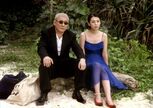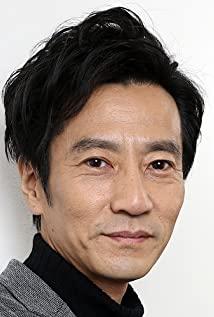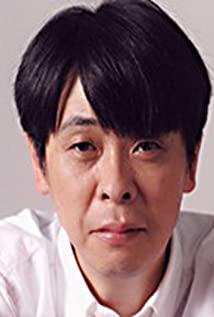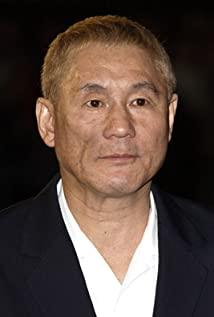"If I had to choose the best 10 films I watched in 2006, I would not Hesitant to include "Two Sided Takeshi Kitano" in it." It
must be admitted that Takeshi Kitano made a very correct choice on the 12th work. He took "Double-sided Takeshi Kitano" as a summary of the first 16 years, and decided to bid farewell to the theme of the past and turn to a new field. This is not grandstanding, but there is a very important meaning in it. Since "Ferocious Man", the unique violent aesthetics formed by Takeshi Kitano have been sought after by many people. However, it must be admitted that his style has actually reached the extreme in "Hua Huo", and then "Big Brother" with a similar theme could not match the achievements of "Hua Huo" anyway, showing a slight decline, and from "Little Sonata" Along the way, "Big Brother" has not made any substantial breakthroughs at all. Afterwards, just like SABU tried to seek a new narrative angle with "Bell of Happiness", Takeshi Kitano minimized the sensual violence, fully exuded the beautiful side of his style through "Doll", and achieved no less than "The Doll". Fireworks achievement. But from the inside, his themes are still about fate and have never changed. His personal style seems to be stuck in a rut, and the subsequent "Zatoichi" is more like a slow-down strategy on the road to breakthrough.
It is conceivable that if he is still obsessed with the theme of "Fireworks", Takeshi Kitano will inevitably dig a grave for himself, and he must know this better. There are two films by the so-called Takeshi Kitano. One starts at the beginning, two gangs fight each other, and only one person remains at the end. This film called "Scorching" comes from the bar shootout in "Little Sonata"; the other One is a film that is being filmed. The gang leader who was hiding on the beach in Okinawa shot his mistress and then committed suicide. This part is more from "Little Sonata". The two sets of scenes are by no means accidental. By reviewing the old works, we can see some stylized things in Kitano's films, which are gradually restraining Kitano's development, and these seem to be perceived by the director himself.
Kitano vs Kitano
The new work "Double-faced Takeshi Kitano" rarely adopts the technique of one person playing two roles. The same technique has been used many times by filmmakers such as Kielovsky and Shunji Iwai. It is not surprising that it is rare that Takeshi Kitano borrowed The meaning that this injects into the film. Like two Takeshi Kitano in the sky and the ground, they are opposites and related, which not only symbolizes the coexistence of violence and beauty in his works over the years, but also implies the existence of contradictions and conflicts in the director's body. As the main color of the film, red and blue accentuate this opposition even more. Behind the seemingly chaotic and miscellaneous story line, the contradiction and inseparability between the two are always prompted. Takeshi Kitano artificially divided himself in two, making the two sides of his body diametrically opposed. Although there are not many actual rivalries between the two Kitano Takeshi, they can still feel the opposition and identification from their respective hearts through the inner drama that is visible on the outside. Just as the director explained in the documentary "Beiye Wushen Happened", in real life he is a cowardly person who only gets beaten in fights, but in the movie he becomes the big brother that everyone admires. Another Japanese director Shinya Tsukamoto also emphasized in an interview the gap between actual Japanese society and film works, that is, the difference between fantasy and reality. Takeshi Kitano puts the duality that he has been thinking about for a long time in the film. In a wide range, you can think that he is revealing human nature, but from his own point of view, this is a rare self-analysis. Although he followed the methods used by his predecessors, Takeshi Kitano actually went further and bolder than them.
I remember a sentence that many people would say when they mentioned Takeshi Kitano, "Looking at his performance in "Hanawa", you wouldn't think that this is the Takeshi Kitano who danced naked with a dancer." Overseas movie fans like Takeshi Kitano because they have far more exposure to movies than TV. In their eyes, Kitano should be cold and humorous. The local Japanese audience didn't like his films because they were already accustomed to the vulgar Takeshi Kitano on TV. In their eyes, he had no relationship with the profound and noble, and that's why they strongly protested Kitano's performance in Zatoichi. Star subverts Katsu Shintaro's established classic image in his mind. However, we have not been able to understand the real Takeshi Kitano after all, just like taking any Kitano in the film alone is one-sided and incomplete. His extremely disjointed duality makes interpretation difficult, and at the same time leaves himself in contradiction and doubt. The film really begins with the signature and ends with the assassination in the elevator. In more than 100 minutes, Takeshi Kitano denied, analyzed, subverted and even denied himself again. The silence after waking up from the two big dreams is the most interesting place for you and me. He reflected on himself from the two positions, introspected, and finally summarized. What Kitano felt in the empty photography studio was no different from Kitano who had just woken up from a nightmare. His fear came more from his denial of himself. Kitano completed a hand-to-hand fight in a dream in a dream, but this fight was hardly fun at all.
When filming "Blood and Bone", Takeshi Kitano interprets the legendary life of a violent and vulnerable fishmonger. This film gave him a real acting feeling. Now it seems that, to a certain extent, it also reflects his inner life. The duality is evident. If you haven't watched the first 11 films of Takeshi Kitano, it's hard to understand the meaning of "Two Sided Takeshi Kitano"
.
This film overlaps the symbols of many of his old works. Just like Kim Ki-duk's retrospective in "The Bow", Kitano's new film can make some people smile. This is probably the main reason why the film of less than two hours makes many people feel procrastination and chaos, and the lack of understanding of the previous work will inevitably cause the audience to understand obstacles.
"Double-faced Takeshi Kitano" is based on "3-4 × October" as a whole, and uses the absurd expression techniques of "Sex Rhapsody" to incorporate the most representative image symbols in the works over the years. As mentioned earlier, from the virtual film "Scorching Heat" from "Little Sonata", Terashima Jin completely copied his image of the immortal gangster in "Sex Rhapsody", and even the widely used time-space dislocation editing is also in "Hana" , "Dolls" and other films can be found, not to mention the ubiquitous spacewalking, tap dancing and beach play. Takeshi Kitano reviewed his past works without hesitation. He used irrational pictures to construct a bizarre, absurd and absurd world. Even if it is much more restrained than "Sex Rhapsody" in terms of jokes, it is no less crazy than the previous work. The strong, high-contrast colors are different from the harmony and fashion created in "Style 5", and it further enhances the film's madness with vulgar and disgusting combinations, which is very similar to "Sex Rhapsody." Of course, Takeshi Kitano didn't just indulge in carnivals. He seemed to be thinking seriously about something behind the chaos. For example, you will find that it has almost all the shooting scenes of the first 11 movies integrated into the new work, but it has never created the violent beauty of "The Doll" or "Big Brother". While avoiding something, he is also deconstructing it, and detouring is more calm and thorough than facing it directly.
dream
In most of Kitano Takeshi's works, dreams occupy an extremely important position. Unlike Akira Kurosawa, Akira Kurosawa did not forget to preach in his dreams, and he did not forget to worry about the country and the people, just like a fake dream to express his Taoism. And Kitano Takeshi's dreams often show a childlike innocence, with occasional images of anxiety and death mixed in. In the creation of dreams, his talent is no less than that of Shuji Terayama, who has magnificent and wild ideas. The earliest is like the long dream in Masahiko Ono's toilet ("3-4 × October"), from the small conflict to the gang rush across the two places, the heroic dream of a small person under the cruel reality, its absurd and bizarre methods and structures have been used in many subsequent works. imitated. Sonata Nakamuragawa's headshot nightmare comes from the game during the day, and at the same time foreshadows the end of his suicide. Usually, Takeshi Kitano uses mute + slow motion to create a chilling atmosphere of death in such scenes. This kind of technique has a strong sense of oppression in the imaginary scene, but when the plot really advances to death, it comes suddenly, and the gap between the front and back is significant. Of course, the most magnificent and bizarre dreams all appear in the two works "Kiujiro's Summer" and "Dolls". It is natural to think about it. One is a child, Masao, and the other is a child with intelligence like a child. Their dreams are different from ordinary people. . However, even these two people have different dreams. Zheng Nan's dreams are full of childishness, and many of them are reflections formed in the dreams of childhood worries, such as the longing for his mother and the red dream mixed with the perverted old man. , the dream of the monster after the temple fair, and the dream of the starry sky before saying goodbye to everyone fully reflect the innocence and innocence of the inner world of children. On the other hand, Zuowako's dreams are much more gloomy than Zhengnan's. The most typical one is the nightmare of being hijacked by a strange person wearing a mask. The mask is an important symbol in "Doll", and its repeated appearance fully reflects Zuohezi's emotional frustration The fear and sadness of her, so although her dream is simple, it is full of instability.
I believe that Takeshi Kitano must have read Freud's "The Interpretation of Dreams". If you analyze it carefully, there are actually traces of dreams in his works. This corresponds to what Freud said, "a dream is a true representation of real life". The above has cited a few examples of old works, and now I will come back to talk about "Double-sided Kitano Takeshi". This film is the second time since "3-4×10" that dreams are the protagonist. After the dream begins with the autograph, the mistress's favor for Terashima Shin makes the two of them form a pair in the dream and play mahjong and chat with the underworld. It led to the audition meeting and the mahjong hall in the dream, and director Kitano's ridicule to Kitano constituted the actual conflict in their dreams, and so on. All life fragments are infinitely enlarged from one point, and through the enlargement, director Kitano completes a calm and long self-examination. In the dream, Kitano's assassination of director Kitano actually constitutes Kitano Takeshi's analysis and criticism of himself in reality. He abandoned the "evil" part by assassinating the corrupt old self to achieve sublimation. From this point of view, "Double-sided Kitano Takeshi" It has already achieved higher achievements than the previous 11 works.
Fragments · Fragments
* The ceramic dolls presented by fans are taken from a scene in "Ferocious Men".
*Wu Zhongmin, a member of the Kitano Takeshi Studio, finally got more drama points. The man who showed three scenes in "Big Brother" and officially debuted as a rookie in "Doll" has never been able to get a heavy role. In "Double-faced Takeshi Kitano", it is even more chilling. He became a full-time driver of Takeshi Kitano, and in reality, this is the profession he joined the studio at the beginning.
*Kitano Takeshi has made golden supporting roles such as Terashima Jin, Osugi Ren, and Kishimoto Kashiko to a certain extent, especially Terashima Jin. As far as I am concerned, in addition to Kitano Takeshi, he also played a role in Cui Yangyi and Hirokazu's films. The real level, the SABU of Shiren Yahui is a pure waste of the acting skills of Terajima Jin and Osugi.
*From DJ playing to women's body, from one-on-one fights to massacres on the beach, the Kitano old man can stay together for another 20 years with these two points alone, especially the latter, which is really a bit higher than "Yizang".
View more about Takeshis' reviews


